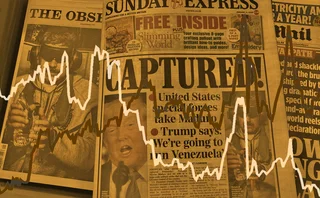
Podcast: Mathieu Rosenbaum on the rough Heston model
Combination of rough volatility and the classical Heston model gives promising results

This Quantcast episode is dedicated to rough volatility models, which originated from attempts to model volatility without assuming its surface is smooth, as implied by, for example, the Black-Scholes model.
Our guest, Mathieu Rosenbaum, head of analytics and models for regulation at the department of applied mathematics of the École Polytechnique, is one of the authors who introduced the concept of rough volatility to finance in 2014, together with Jim Gatheral and Thibault Jaisson (Gatheral et al, 2014), and has contributed to develop models in this area since.
According to Rosenbaum, these models are set to become more popular because of their ability to describe markets’ volatility accurately. “It is very hard to reject that volatility is rough on historical data and it is very hard to reject that volatility is rough on implied volatility data,” says Rosenbaum.
In addition, he points out their specification is very parsimonious. There are only three parameters: volatility level, volatility of volatility and spot/vol correlation.
His latest work, Roughening Heston, is co-authored with Omar El Euch and Jim Gatheral. It extends the original rough volatility model combining it with the classical Heston model.
Rosenbaum explains the issues related to applicability and implementation of the rough Heston model. Also, he offers his answers to some of the criticisms the model has received, such as the limited applicability of a non-Markovian model and the precision of the fitting of a model with only three parameters.
INDEX
00:00 Intro
01:15 What is rough volatility?
02:25 Development of the model
04:15 Advantages of rough volatility
06:32 Rough Heston paper
09:02 Implementation
11:25 Rough volatility with other volatility models
12:50 What products can rough volatility be applied to
13:35 Limited applicability of non-Markovian models?
16:25 Poor man’s rough Heston model
18:24 Fitting precision
21:20 Are banks using it?
References
Jim Gatheral, Thibault Jaisson, Mathieu Rosenbaum (2014)
Volatility is rough
https://arxiv.org/abs/1410.3394
To hear the full interview, listen in the player above, or download. Future podcasts in our Quantcast series will be uploaded to Risk.net. You can also visit the main page here to access all tracks, or go to the iTunes store or Google Podcasts to listen and subscribe.
Only users who have a paid subscription or are part of a corporate subscription are able to print or copy content.
To access these options, along with all other subscription benefits, please contact info@risk.net or view our subscription options here: http://subscriptions.risk.net/subscribe
You are currently unable to print this content. Please contact info@risk.net to find out more.
You are currently unable to copy this content. Please contact info@risk.net to find out more.
Copyright Infopro Digital Limited. All rights reserved.
As outlined in our terms and conditions, https://www.infopro-digital.com/terms-and-conditions/subscriptions/ (point 2.4), printing is limited to a single copy.
If you would like to purchase additional rights please email info@risk.net
Copyright Infopro Digital Limited. All rights reserved.
You may share this content using our article tools. As outlined in our terms and conditions, https://www.infopro-digital.com/terms-and-conditions/subscriptions/ (clause 2.4), an Authorised User may only make one copy of the materials for their own personal use. You must also comply with the restrictions in clause 2.5.
If you would like to purchase additional rights please email info@risk.net
More on Markets
Brokers must shift HFT servers after China colocation ban
New exchange guidance drives rush for “proximity colo” in nearby data centres
LatAm FX carry trade shrugs off geopolitical fears
Clients in regional carry positions remain undeterred by US interventions, say dealers
S&P bull run drives interest in reset and lookback hedges
Variable strike put options proved popular alternative hedging format of 2025
US mutual funds slash short euro positions at record pace
Counterparty Radar: Pimco cut $4.6bn of EUR/USD puts in Q3 amid changing stance on dollar direction
Nomura hires new global eFX head
Mark McMillan to oversee e-trading and sales activities in newly created role
Trump’s LatAm gambit spurs FX hedging rush
Venezuela op boosts risk reversals as investors look to protect carry trades
One Trading brings 24/7 equity trading to Europe
Start-up exchange will launch perpetual futures Clob in Q1 after AFM nod
FXGO volumes surge despite fee switch-on
Dealers split on whether levy is behind volume increases across SDPs







